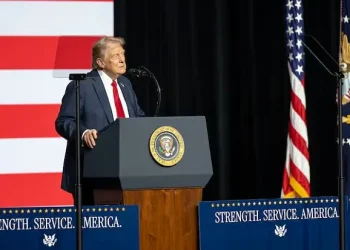A significant shift is underway in U.S. defense strategy. At a Pentagon press briefing, Chief Spokesman Sean Parnell presented a detailed update on military aid, border security, global operations, and modernization efforts shaping national defense priorities.
Introduction
On July 2, 2024, at the Pentagon, Chief Spokesman Sean Parnell briefed the press on evolving U.S. defense strategy.
The session covered Ukraine aid reassessment, strikes on Iran’s nuclear program, expanded border security roles, military recruitment, and defense modernization.
These developments mark a recalibration of America’s defense posture at home and abroad.
Ukraine Aid Under Strategic Review
The Department of Defense (DOD) is pausing aspects of U.S. military aid to Ukraine as part of a broader capability review. This temporary reassessment ensures that resources align with U.S. defense priorities while maintaining military readiness.
According to Parnell, this approach reflects a shift from open-ended aid towards “measured, sustainable support.” The review addresses growing concerns over depleted inventories and strategic resource management.
Why It Matters
-
Ensures aid aligns with U.S. defense needs
-
Balances Ukraine support with maintaining military readiness
-
Reflects a more controlled, sustainable foreign policy
However, Ukrainian officials warn that reduced aid may embolden Russia, potentially prolonging the conflict and worsening civilian hardship.
Strikes on Iran’s Nuclear Program
In partnership with Israel, the U.S. conducted targeted strikes on Iran’s nuclear facilities under Operation Midnight Hammer.
These strikes, described by defense officials as “decisive,” have reportedly delayed Iran’s nuclear ambitions by up to two years.
Regional Impact
The operation helped restore a ceasefire after a 12-day conflict between Iran and Israel. It also reinforced the U.S. commitment to preventing a nuclear-armed Iran, fulfilling a longstanding security promise.
While allies praised the strikes, experts and the International Atomic Energy Agency caution that Iran could resume enrichment activities within months.
Increased Military Role at U.S. Southern Border
The Pentagon confirmed that 8,500 personnel remain deployed along the U.S.-Mexico border, supporting Customs and Border Protection.
New National Defense Areas (NDAs) have been established in Texas and Arizona, enhancing operational control and infrastructure security.
Local Implications
Communities along the Rio Grande and near Yuma, Arizona, can expect increased military presence. This includes logistical operations, surveillance, and property protection missions conducted by National Guard units.
Defense Posture Developments
| Defense Area | Recent Update | Implication |
|---|---|---|
| Ukraine Aid | Strategic pause and review underway | Ensures alignment with U.S. defense needs |
| Iran’s Nuclear Program | Targeted strikes delayed enrichment efforts | Demonstrates U.S. deterrence capabilities |
| Southern Border | Expanded NDAs and military support | Reinforces border security infrastructure |
| Recruitment | Air Force, Space Force, Navy met recruiting goals | Positive sign amid long-term service decline |
| Modernization Efforts | Senate defense bill passed | Investments in AI, unmanned systems, quality of life |
Recruitment Success Amid Long-Term Challenges
Parnell reported that the Air Force, Space Force, and Navy have surpassed their recruitment targets ahead of schedule. This success follows leadership changes and renewed promotion of military service as a viable career.
Yet, the Pentagon acknowledges deeper challenges.
The “propensity to serve” among young Americans has dropped to historic lows—between 7% and 11%, prompting the formation of a recruiting task force to improve community engagement and cultural outreach.
Defense Budget and Modernization Efforts
The Senate recently passed a comprehensive defense bill described as a “once-in-a-generation” opportunity to modernize U.S. defense capabilities. Key provisions include:
-
Major investments in shipbuilding, artificial intelligence, and unmanned systems
-
Initiatives to improve service member quality of life
-
Economic support for defense industries and military communities
This modernization push aims to enhance U.S. competitiveness and strengthen global security commitments.
Leadership and Global Posture Updates
Lt. Gen. Alex Grynkewich has been appointed Supreme Allied Commander Europe, succeeding Gen. Christopher Cavoli. This leadership change underscores the U.S. commitment to NATO and European security.
Meanwhile, the DOD has initiated a lessons-learned review of the Afghanistan withdrawal, aiming to avoid strategic missteps in future conflicts.
No current troop level changes are planned for Syria or South Korea, though ongoing posture reviews continue.
Parting Shot
The Pentagon’s latest briefing reflects a deliberate recalibration of U.S. defense strategy—balancing assertive actions abroad, domestic resource management, expanded border roles, and long-term military sustainability.
These developments carry wide-ranging implications for national security, local communities, and global stability.
For continued coverage and expert analysis on U.S. defense developments, follow our latest reports.
Sources: US Department of Defense.
Prepared by Ivan Alexander Golden, Founder of THX News™, an independent news organization delivering timely insights from global official sources. Combines AI-analyzed research with human-edited accuracy and context.








